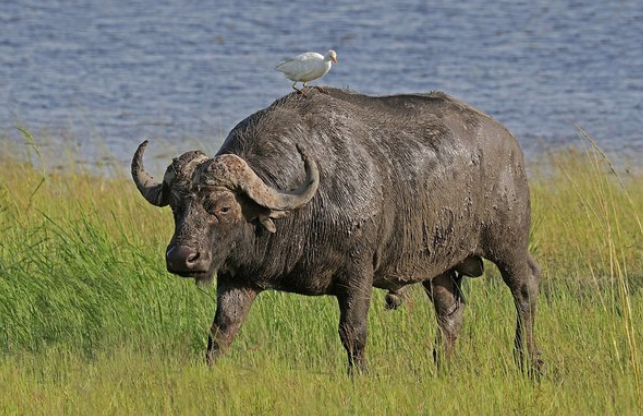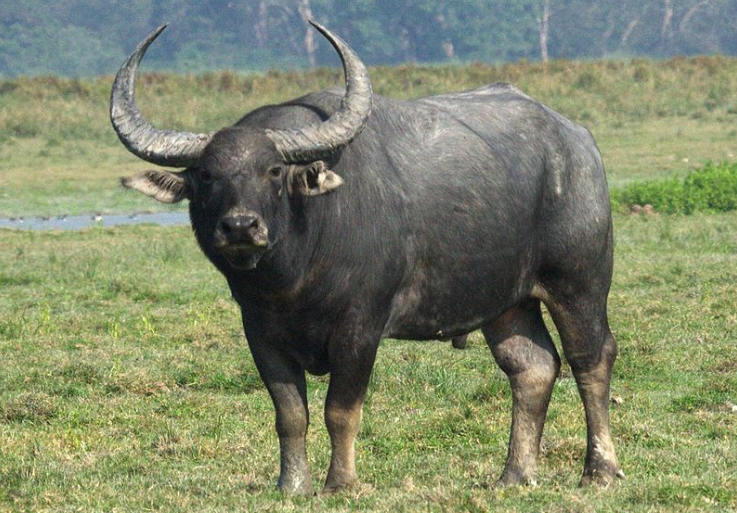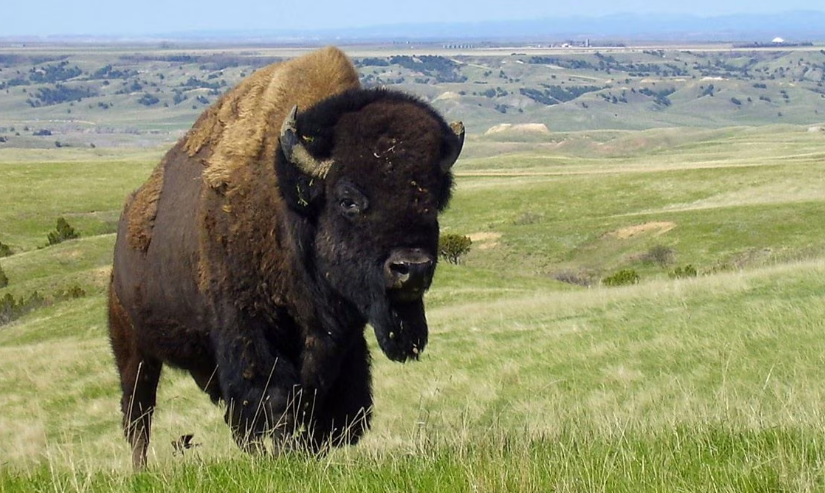Buffalo
A buffalo is a large, bovine mammal found in Africa and Asia. It is usually black or dull black in color. A buffalo is a very robust species. There are two primary species of buffalo: the Water or Asian buffalo (Bubalus bubalis) and the African buffalo (Syncerus caffer).
Much like the American bison, the African buffalo (also known as the Cape buffalo) is an impressive and imposing animal. Standing at over six feet tall and weighing up to 2,000 pounds. These animals are mostly found throughout sub-Saharan Africa within humid savannahs, grasslands, and dense forests.

Its massive head – crowned with a pair of impressively large horns – and shaggy coat are distinctive features. The buffalo’s coat is colored black or dark brown with a reddish tinge. The coat has two layers: The long, coarse outer layer is called the “guard hair”, and the dense, wooly undercoat is used to keep the buffalo warm. The buffalo’s hump is formed by a large muscle called the “dorsal caruncle”, which is used to power the animal’s head movements. The buffalo’s hump is one of the largest in the animal kingdom.
The water buffalo, or Asian buffalo, as it is often called, is the largest member of the Bovini tribe, which includes yak, bison, African buffalo, various species of wild cattle, and others.
Standing 5 to 6.2 feet tall at the shoulder, wild water buffalo are formidable mammals with sparse gray-black coats. Males carry enormous backward-curving, crescent-shaped horns stretching close to 5 feet long with deep ridges on their surface. Females are smaller in size and weight, but they also have horns, although they are proportionately smaller.

Water buffalo spend much of their day submerged in the muddy waters of Asia’s tropical and subtropical forests. Their wide-splayed hoofed feet prevent them from sinking too deeply in the mud and allow them to move about in wetlands and swamps. These marshes provide good cover and rich aquatic plants to forage on, although water buffalo actually prefer to feed in grasslands on grass and herbs.
What You Need To Know About Bison
African Buffalo (Syncerus caffer)
- Size: African buffalo are large mammals, with males (bulls) weighing between 1,100 to 2,200 pounds and standing up to 5.6 feet tall at the shoulder.
- Horns: They have distinctive, curved horns that sweep backward, forming a continuous curve around their heads.
- Social Behavior: African buffalo are known for their strong social structure and often live in large herds, which can consist of hundreds of individuals.
- Habitat: They inhabit a variety of ecosystems, including savannas, grasslands, and woodlands, and are well-adapted to both wet and dry environments.
- Diet: These herbivores graze on grasses and occasionally browse on shrubs and trees. They are known as “grazers.”
- Behavior: African buffalo can be unpredictable and are considered one of the most dangerous animals in Africa. They are known to be highly protective of their herd and will defend themselves fiercely against predators.
- Reproduction: Mating can occur year-round, but there is often a peak during the rainy season. Calves are typically born after a gestation period of around 11 months.
- Conservation Status: African buffalo are considered a species of “Least Concern” by the International Union for Conservation of Nature (IUCN), meaning they are not currently facing a high risk of extinction.
Asian Buffalo (Bubalus bubalis)
- Size: Asian buffalo, such as the water buffalo, are generally smaller than their African counterparts, with males weighing between 1,000 to 2,200 pounds.
- Horns: They have curved horns, but the shape and size can vary between different Asian buffalo species.
- Domestication: Asian buffalo, particularly water buffalo, have been domesticated for thousands of years and are used as draft animals, for milk production, and as a source of meat and leather.
- Variety: There are different subspecies of Asian buffalo, including the water buffalo, the swamp buffalo, and the carabao, each adapted to specific habitats and purposes.
- Cultural Significance: In many Asian cultures, buffalo play a vital role in agriculture and are often revered and celebrated in festivals and traditions.
- Behavior: Domesticated Asian buffalo are generally docile and well-suited for working in fields and pulling plows.
- Diet: They are herbivorous and primarily feed on grasses and aquatic plants in their natural habitat.
- Conservation Status: Domesticated Asian buffalo are not considered endangered, but there may be conservation concerns for some wild populations, especially the lowland anoa and tamaraw species.
African vs Asian Buffalo: What is the difference
| Feature | African Buffalo (Syncerus caffer) | Asian Buffalo (Bubalus spp.) |
|---|---|---|
| Geographic Range | Primarily Africa | Asia, with sub-species like the Water Buffalo in South Asia |
| Horn Shape | Wider and curve outward | Smaller and curve inward (V-shaped) |
| Size | Larger, with males weighing up to 900 kg (2,000 lbs) | Smaller, with males weighing up to 1,000 kg (2,200 lbs) |
| Coat Color | Dark brown to black | Light gray to dark brown |
| Habitat | Grasslands, savannas, and forests | Wetlands, swamps, and rice fields |
| Behavior | More aggressive and unpredictable | Generally more docile and domesticated |
| Social Structure | Tend to form smaller groups or solitary individuals | Often found in larger herds |
| Diet | Graze on grasses and browse on shrubs | Herbivorous, grazing on grass and aquatic plants |
| Horns | Heavier and used for defense | Lighter, used for digging and fighting |
Bison

Bison, also commonly known as the American buffalo, it is the largest mammal in North America. It grows between 7 to 11.5 feet long, from head to rump. The American bison can be found in the United States, Canada and Mexico, mostly in conservation areas, preserves or farms. Bison can be dark brown, brown or maroon in color and can weigh up to 1400 kg.
American Bison were once near extinction due to overhunting and habitat loss. However, conservation efforts have led to their population recovery, and they are no longer considered endangered.
Bison hold cultural and historical significance in North America and are often considered an iconic symbol of the American West. They are also the national mammal of the United States.
What You Need To Know About Buffalo
- Size: Bison are among the largest land mammals in North America, with adult males (bulls) weighing up to 2,000 pounds and standing about 6 feet tall at the shoulder.
- Hump: They have a hump on their shoulders, which is composed of muscle and supported by powerful vertebrae. This hump is more prominent in males than females and is used for digging through snow in winter.
- Horns: They have short, curved horns that grow from their foreheads. These horns are used for defense and are present in both males and females.
- Fur: Their fur is dark brown to reddish-brown and provides insulation against harsh weather conditions. It can be long and shaggy, especially during the winter months.
- Hooves: They have large, cloven hooves that help them navigate various terrains, including snow and grasslands. Their hooves are adapted for digging through snow to reach grass in the winter.
- Herbivorous Diet: They are herbivores, grazing on grasses, sedges, and other vegetation. They are often referred to as “grazers.”
- Social Behavior: They are known for their social behavior and form small family groups, consisting of females (cows) and their offspring, led by a dominant male (bull). These groups can gather into larger herds during certain times of the year.
- Mating Season: Bison mate in late summer to early fall, with calves usually born in the spring. During the mating season, dominant males compete for access to females.
Bison vs Buffalo: Key Differences
| Feature | Buffalo (African and Asian) | Bison (American) |
|---|---|---|
| Scientific Name | Various species within Bovidae family | Bison bison (American Bison) |
| Geographic Range | Africa and Asia | North America |
| Physical Size | Generally smaller and lighter | Larger and heavier |
| Hump Shape | No prominent hump | Prominent hump |
| Horn Shape | Sweep backward and slightly curved | Short, thick, and curved inward |
| Horn Size | Typically longer and more curved | Shorter and thicker |
| Social Structure | Often live in large herds | Tend to be in smaller groups |
| Habitat | Varied habitats, including forests, grasslands, and wetlands | Grasslands and prairies |
| Behavior | Can be domesticated | Wild and typically not domesticated |
| Fur Color | Various colors depending on the species | Dark brown to reddish-brown |
| Mating Season | Throughout the year in some cases | Typically in late summer to early fall |
| Predation Threat | Vulnerable to predation by large carnivores | Few natural predators |
| Conservation Status | Some species are endangered | Bison have rebounded from near extinction |
| Range of Species | Includes water buffalo, cape buffalo, and others | Mainly American Bison |
| Horn Tips | Tend to be sharp at the tips | Rounded at the tips |
